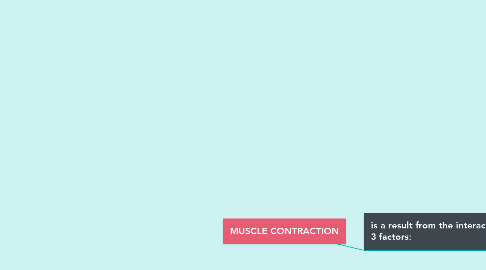
1. is a result from the interaction of 3 factors:
1.1. NEUROELECTRICAL FACTOR (1ST)
1.1.1. Starts when nerve impulses are received from the nervous system
1.1.2. The impulses travels to the neuromuscular junction
1.1.3. Then it triggers the axons terminals to release acetylcholine wherein it causes sodium ions to rush inside the muscle cell
1.1.4. This rapid influx of sodium ions creates an electrical potential that travels in both directions along the muscle cell
1.1.5. This influx of sodium ions causes the inside of the cell to go from becoming electrically negative to being positive
1.1.6. Wherein this is a signal to the muscle cell to generate its own impulse or action potential.
1.1.7. This signals the muscle to contract
1.2. CHEMICAL INTERACTIONS (2ND)
1.2.1. The release of calcium ions from the sarcoplasmic reticulum
1.2.2. Due to the calcium ions, this inhibits the activity of troponin and tropomyosin
1.2.3. Next, the calcium ions attach to the myosin which makes the myosin activated myosin
1.2.4. The the activated myosin releases the energy from the ATP at the ac tin active site when the myosin links up and forms actomyosin
1.2.5. The head linkage makes a cross-bridge that pulls the actin filaments inward among the myosin filaments and breaks down the ATP into ADP and PO4
1.2.6. The release of energy then causes contraction
1.3. ENERGY SOURCES (3RD)
1.3.1. The energy given off by the breakdown of ATP is used when the actin and myosin filaments intermesh
1.3.2. ATP is then synthesized by glycolysis, the Krebs citric acid cycle, electron transport and in muscles, by the breakdown of phosphocreatine
1.3.3. It then converts it to energy and results to muscle contraction
